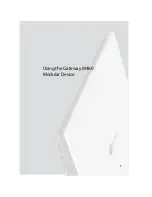
F800 CIRCUIT DESCRIPTION
15 (25)
Uppgjord (även faktaansvarig om annan) -
Prepared (also subject responsible if other)
Nr
-
No.
KL/ECS/S/LT Magnus Lindahl
ECS/S/LT-96:5044
Dokansv/Godk -
Doc respons/Approved
Kontr
-
Checked
Datum
-
Date
Rev
File
KI/ECS/S/LTC
1996-06-06
A
965044.DOC
The same principal also applies to the other frequency bands but with different break
frequencies and also for F802 different 1st IF frequency.
After the 1st mixer the signal, 1st IF, is connected to impedance matching amplifier
stage before the signal is passed through a crystal filter tuned for the 1st IF. After the
crystal filter, a pure 1st IF is obtained that is connected to an impedance matching
buffer stage. The buffer stage is followed by an amplifier stage with a tuned filter in the
collector path. The filter is then tuned for the 1st IF. The 1st IF signal, 21,4 MHz, is
then connected to the 2nd IF circuit.
2nd IF and demodulator
The 2nd IF is implemented in two integrated circuits with the following functions:
#"
2nd local oscillator
#"
2nd mixer
#"
2nd IF amplifier
#"
RX limiter
#"
Demodulator
#"
Signal strength indicator
There are a small number of external components in the 2nd IF. The major external
components are the detector coil, the 2nd LO crystal and a 455 kHz crystal filter. All
major IF functions are found in two integrated circuits, containing the 2nd oscillator
and 2nd mixer. The other IC contains an amplifier for the 2nd IF, limiter and the
demodulator. The second IF circuit also contains an RSSI output. The signal
corresponds to the signal strength received in the 2nd IF. The IF circuits have internal
temperature compensation. The 2nd IF circuit has two audio outputs, one muted and
one unmuted. The unmuted output is not used in F800. The sensitivity of the 2nd IF
circuit is high. Typical sensitivity is > -110 dBm !
Dedector, Limiter & RSSI
part of IC
2nd Mixer & 2nd LO
part of IC
21,4 MHz
Osc
.
21,855 MHz
455 kHz
From 1st
Mixer
RSSI
AF
Detector Coil
Fig J: Blockdiagram IF circuits
















































